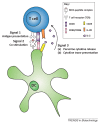Towards efficient cancer immunotherapy: advances in developing artificial antigen-presenting cells
- PMID: 24998519
- PMCID: PMC4154451
- DOI: 10.1016/j.tibtech.2014.06.007
Towards efficient cancer immunotherapy: advances in developing artificial antigen-presenting cells
Abstract
Active anti-cancer immune responses depend on efficient presentation of tumor antigens and co-stimulatory signals by antigen-presenting cells (APCs). Therapy with autologous natural APCs is costly and time-consuming and results in variable outcomes in clinical trials. Therefore, development of artificial APCs (aAPCs) has attracted significant interest as an alternative. We discuss the characteristics of various types of acellular aAPCs, and their clinical potential in cancer immunotherapy. The size, shape, and ligand mobility of aAPCs and their presentation of different immunological signals can all have significant effects on cytotoxic T cell activation. Novel optimized aAPCs, combining carefully tuned properties, may lead to efficient immunomodulation and improved clinical responses in cancer immunotherapy.
Keywords: artificial antigen-presenting cell; cancer; immunotherapy; synthetic dendritic cell.
Copyright © 2014 The Authors. Published by Elsevier Ltd.. All rights reserved.
Figures



Similar articles
-
Biodegradable Cationic Polymer Blends for Fabrication of Enhanced Artificial Antigen Presenting Cells to Treat Melanoma.ACS Appl Mater Interfaces. 2021 Feb 24;13(7):7913-7923. doi: 10.1021/acsami.0c19955. Epub 2021 Feb 12. ACS Appl Mater Interfaces. 2021. PMID: 33573372 Free PMC article.
-
Biologically Inspired Design of Nanoparticle Artificial Antigen-Presenting Cells for Immunomodulation.Nano Lett. 2017 Nov 8;17(11):7045-7054. doi: 10.1021/acs.nanolett.7b03734. Epub 2017 Oct 10. Nano Lett. 2017. PMID: 28994285 Free PMC article.
-
Nanoscale artificial antigen presenting cells for cancer immunotherapy.Mol Immunol. 2018 Jun;98:13-18. doi: 10.1016/j.molimm.2018.02.016. Epub 2018 Mar 7. Mol Immunol. 2018. PMID: 29525074 Free PMC article. Review.
-
Artificial antigen-presenting cells expressing HLA class II molecules as an effective tool for amplifying human specific memory CD4(+) T cells.Immunol Cell Biol. 2016 Aug;94(7):662-72. doi: 10.1038/icb.2016.25. Epub 2016 Feb 29. Immunol Cell Biol. 2016. PMID: 26924643
-
Particle-Based Artificial Antigen-Presenting Cell Systems for T Cell Activation in Adoptive T Cell Therapy.ACS Nano. 2024 Mar 26;18(12):8571-8599. doi: 10.1021/acsnano.3c10180. Epub 2024 Mar 14. ACS Nano. 2024. PMID: 38483840 Review.
Cited by
-
Cell surface morphology mimicking nano-bio platform for immune cell stimulation.iScience. 2024 Sep 26;27(11):111033. doi: 10.1016/j.isci.2024.111033. eCollection 2024 Nov 15. iScience. 2024. PMID: 39498306 Free PMC article.
-
Current updates on generations, approvals, and clinical trials of CAR T-cell therapy.Hum Vaccin Immunother. 2022 Nov 30;18(6):2114254. doi: 10.1080/21645515.2022.2114254. Epub 2022 Sep 12. Hum Vaccin Immunother. 2022. PMID: 36094837 Free PMC article.
-
Redirecting Specificity of T cells Using the Sleeping Beauty System to Express Chimeric Antigen Receptors by Mix-and-Matching of VL and VH Domains Targeting CD123+ Tumors.PLoS One. 2016 Aug 22;11(8):e0159477. doi: 10.1371/journal.pone.0159477. eCollection 2016. PLoS One. 2016. PMID: 27548616 Free PMC article.
-
A library-based screening method identifies neoantigen-reactive T cells in peripheral blood prior to relapse of ovarian cancer.Oncoimmunology. 2017 Sep 21;7(1):e1371895. doi: 10.1080/2162402X.2017.1371895. eCollection 2017. Oncoimmunology. 2017. PMID: 29296522 Free PMC article.
-
Cell Membrane-Based Biomimetic Nanoparticles and the Immune System: Immunomodulatory Interactions to Therapeutic Applications.Front Bioeng Biotechnol. 2020 Jun 17;8:627. doi: 10.3389/fbioe.2020.00627. eCollection 2020. Front Bioeng Biotechnol. 2020. PMID: 32626700 Free PMC article. Review.
References
-
- Nelson A.L. Development trends for human monoclonal antibody therapeutics. Nat. Rev. Drug Discov. 2010;9:767–774. - PubMed
Publication types
MeSH terms
Grants and funding
LinkOut - more resources
Full Text Sources
Other Literature Sources
Miscellaneous

